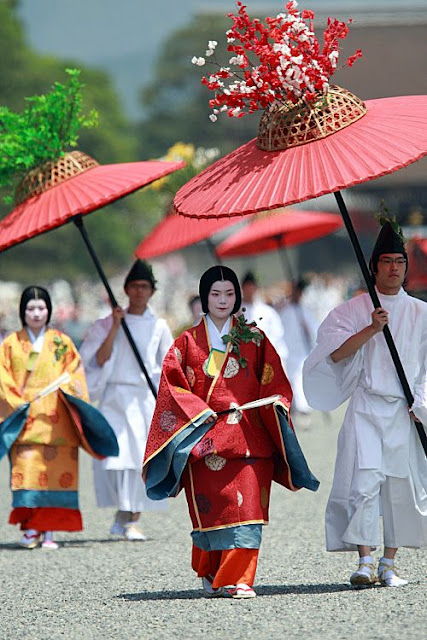Modern Japanese fashion history might be conceived as the very gradual westernization of Japanese clothes. The woolen and worsted industries were completely a product of Japan’s re-established contact with the West in the 1850s and 1860s. Before the 1860s, Japanese clothing consisted entirely of a great variety of kimono.

Originally, "kimono" was the Japanese word for clothing. But in more recent years, the word has been used to refer specifically to traditional Japanese clothing. Kimonos as we know them today came into being during the Heian period (794-1192).

From the Nara period (710-794) until then, Japanese people typically wore either ensembles consisting of separate upper and lower garments (trousers or skirts), or one-piece garments. But in the Heian period, a new kimono-making technique was developed. Known as the straight-line-cut method, it involved cutting pieces of fabric in straight lines and sewing them together. With this technique, kimono makers did not have to concern themselves with the shape of the wearer's body.
Straight-line-cut kimonos offered many advantages. They were easy to fold. They were also suitable for all weather: They could be worn in layers to provide warmth in winter, and kimonos made of breathable fabric such as linen were comfortable in summer. These advantages helped kimonos become part of Japanese people's everyday lives.

After Japan opened up for trading with the outside world, other clothing options started to come in. The first Japanese to adopt western clothing were officers and men of some units of the shogun's army and navy.
Sometime in the 1850s these men adopted woolen uniforms worn by English marines stationed at Yokohama. To produce them could not have been easy. The cloth had to be imported. Perhaps the most significant of this early adoption of Western styles was its public origin. For quite a while, the public sector remained as major champion of the new garb.

Up until the fifteenth century kimonos were made of hemp or linen, and they were made with multiple layers of materials. Today, authentic kimonos are made of silk, silk brocade, silk crepes (such as chirimen) and satin weaves (such as rinzu). Modern kimonos that are made with less-expensive easy-care fabrics such as rayon, cotton sateen, cotton, polyester and other synthetic fibers, are more widely worn today in Japan. However, silk is still considered the ideal fabric for kimonos.
Sublimation printing is a technique that uses heat sensitive inks. These inks turn into gas under the influence of heat and combine with a 100% polyester medium. Since the ink becomes part of the structure of the material, the images on the fabric don’t fade or crack - even after multiple washings.

It allows more color and pattern and high quality transfer rate in kimono. To create high-quality sublimation prints, you need a transfer paper that has high ink absorption and dries quickly. The paper needs to stay flat and may not wave after printing. It is also important that the paper releases the ink when heating. The Roland Sublimation Paper does all that and is therefore the perfect paper for your sublimation prints.



No comments:
Post a Comment